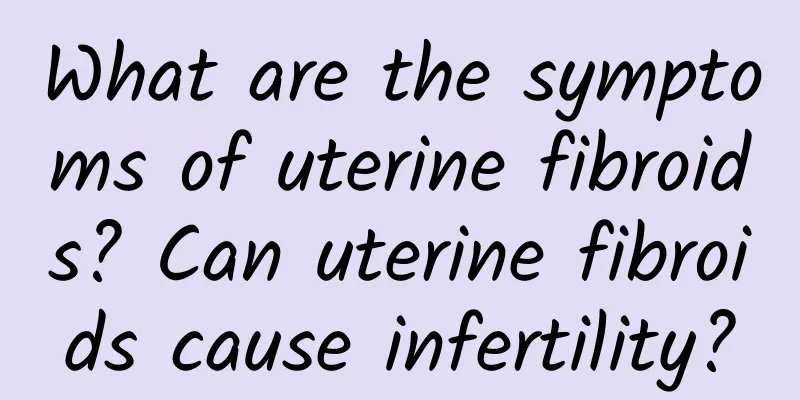What are the symptoms of uterine fibroids? Can uterine fibroids cause infertility?

|
Uterine fibroids are a widespread gynecological disease that has a great impact on women's physical and mental health. Therefore, if a woman finds that she has the corresponding symptoms of uterine fibroids, she must seek timely treatment. So, what are the symptoms and signs of uterine fibroids? According to statistics, about 1/3 of patients with uterine fibroids are asymptomatic. The clinical manifestations are mainly related to the location of their growth. The symptoms and signs are as follows: Uterine bleeding Uterine bleeding is the most common symptom, mainly manifested as heavy menstrual flow, prolonged menstruation, frequent menstruation or irregular bleeding. Submucosal fibroids and large intramural fibroids are prone to bleeding, with large amounts of blood, necrosis and infection. The main causes of bleeding are: increased endometrial area, increased endometrial blood supply, endometrial hyperplasia, uterine contraction disorders, and pelvic congestion complications. Subserosal fibroids can cause uterine bleeding. 2. Abdominal mass When the fibroids gradually grow larger without other obvious symptoms, they will manifest as a swollen and asymmetrical abdomen, with a hard, irregular mass felt in the lower abdomen. The uterus and fibroids will be more easily palpable when the swelling and filling push the uterus and fibroids upward. 3. Compression symptoms When fibroids grow and compress adjacent tissues and organs, they will produce corresponding symptoms and signs. When fibroids on the anterior wall of the uterus or cervix compress the bladder, frequent urination, dysuria, and urinary retention may occur. 4. Infertility Uterine fibroids change the shape of the uterine cavity, reduce the patency of the fallopian tubes and uterine cavity, or act as foreign bodies to affect the movement of sperm and fertilized eggs and the implantation of fertilized eggs. It is still possible to have children after myomectomy. 5. Increased leucorrhea When the submucosal fibroids separate from the uterine opening, the surface mucosa becomes infected, ulcerated, and necrotic, which may produce a large amount of bloody or foul-smelling leucorrhea. 6. Pain Subserosal fibroids may torsion or cause uterine torsion and compress local nerves. Submucosal fibroids may stimulate uterine contraction or cervical dilation. Infection may lead to pelvic inflammatory disease, uterine fibroid degeneration, endometriosis, etc. 7. Systemic symptoms Excessive uterine bleeding can cause secondary anemia. If severe anemia is not corrected in time, it can cause anemic heart disease, resulting in corresponding symptoms such as chest tightness and palpitations. 8. Physical signs The physical signs depend on the size, number, location, etc. of the uterine fibroids. Uterine fibroids, such as 3-4 months of pregnancy, can be found in the lower abdomen and irregular lumps. For smaller ones, they can only be found during pelvic examination. Broad ligament fibroids usually push the uterus to measure; the uniformity of intramural fibroids increases; the air mouth of patients with submucosal fibroids is loose, and the fingers can enter the cervical canal to touch the tumor, and the uniformity of the uterus increases; pedicled submucosal fibroids can also prolapse the cervix, and the surface is often congested, ulcerated, infected, necrotic, etc.; the increase of fibroids can fill the entire pelvic cavity and even enter the abdominal cavity; fibroids become soft, tender, and calcified. The above are the symptoms of patients with uterine fibroids. We can diagnose and identify uterine fibroids based on these, which is very important in the early stages. The appearance of uterine fibroids is a major hidden danger to women's health. It is best to cure it as soon as possible, otherwise it is likely to leave sequelae. |
<<: What are the symptoms and causes of uterine fibroids?
>>: What are the common uterine fibroids? What are the symptoms of uterine fibroids?
Recommend
Ovarian cyst examination method revealed
The ovaries are women's private gardens and b...
How much does an abortion usually cost?
Nowadays, people's minds are more open, so mo...
The main symptoms of irregular menstruation
Irregular menstruation occurs in many women, and ...
Diet adjustment for vulvar itching
The vulva is a relatively private area of women...
What medicine should I take for adnexitis?
Adnexitis can usually be treated with medicines s...
Is irregular menstruation hereditary?
Is irregular menstruation hereditary? Irregular m...
Experts explain the reasons why infertile women suffer from uterine fibroids
It is understood that in recent years, many women...
Can I have a child with uterine fibroids?
Uterine fibroids are the most common pelvic tumor...
What medicine can eliminate pelvic effusion the fastest?
There is no saying that what medicine can elimina...
Under what circumstances can uterine fibroids be operated on? Surgical treatment of uterine fibroids
There are many female friends suffering from uter...
Where do single women's gynecological diseases come from? These points may be more critical than you think
In today's increasingly information-rich worl...
What are the main symptoms of irregular menstruation in girls?
Irregular menstruation is one of the manifestatio...
What are the harms of abortion anesthesia to the body? What should women pay attention to after abortion
Painless abortion is very common nowadays, and mo...
Pituitary tumors often cause amenorrhea
Pituitary tumors account for about 10% of all int...
What's wrong with having two periods in one month?
What's wrong with having two periods in one m...









